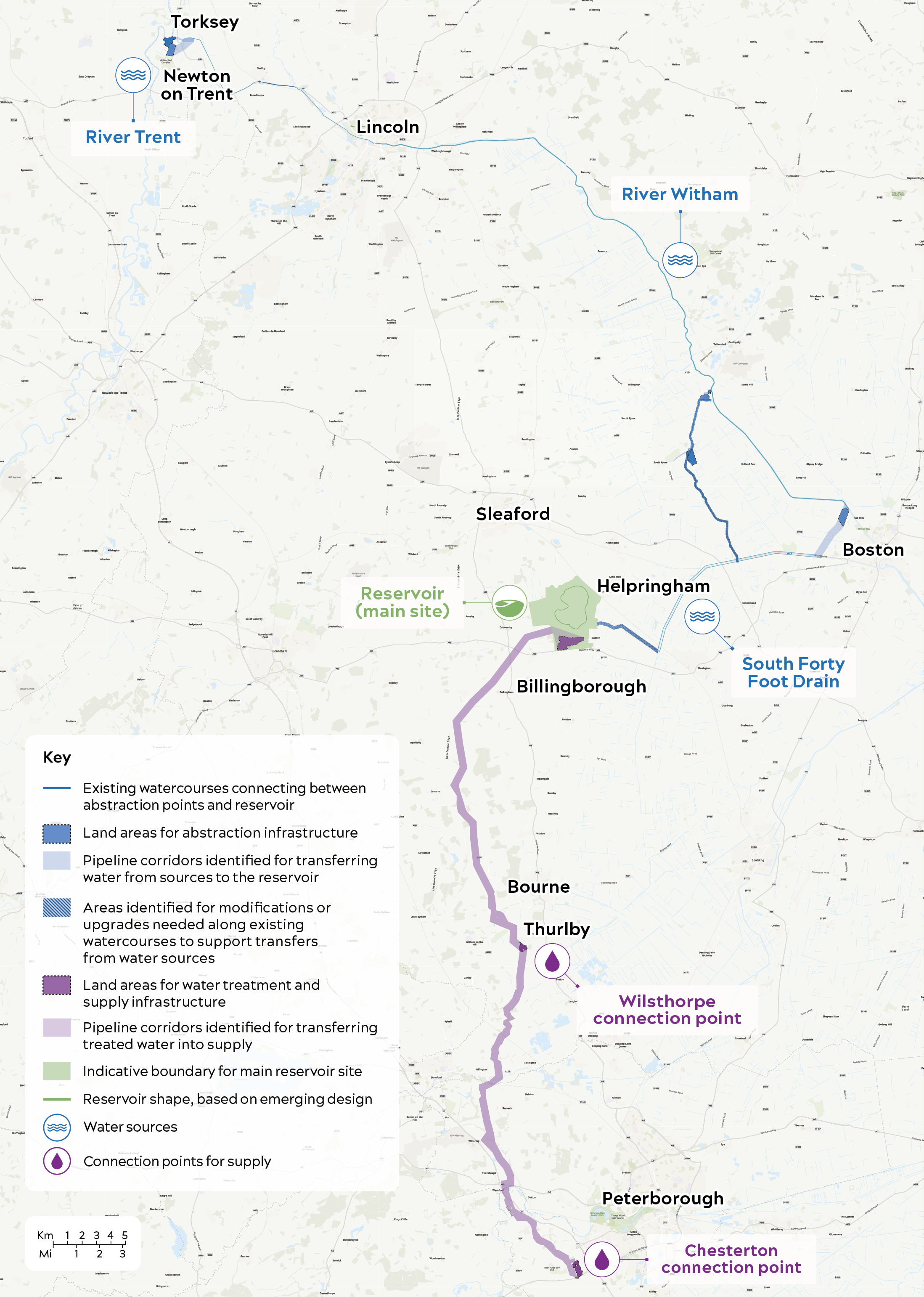Associated water infrastructure
Identifying the right options
We’ve completed a multi-stage assessment to identify preferred ways for transferring water to and from the reservoir, and the infrastructure needed.
We started by looking across the broad area between the water sources, the reservoir and the connection points to identify a list of locations and options for the infrastructure we might need.
We then looked at this long list of options and assessed them to see which ones were most suitable for what we needed to build, taking into account factors such as existing infrastructure, environmental designations and planning policy. The most suitable options were then assessed in more detail against a range of criteria including:
- Engineering: what the construction of the infrastructure would involve, and the need to design and build in a safe, and carbon and cost-efficient manner. We also considered how the infrastructure could interact with existing rivers and watercourses.
- Environment: natural environment features such as existing rivers and watercourses, nature conservation areas, landscape designations, and the historic environment.
- Planning and land use: considering each option for the presence of other nationally significant infrastructure projects, as well as features such as designated common land and mineral safeguarding zones.
- Social and community: Existing built-up areas, community infrastructure, and access and amenity resources.
We also looked at potential opportunities that the different options might unlock, including whether they could enhance the environment, support existing water resources management initiatives or unlock navigation opportunities.
We took forward the options that were preferred based on the wide range of criteria considered,, and then looked at how the options could work together to collect, treat and distribute water to homes and businesses.
This helped us identify a preferred combination.
You can read about this process in our Options Appraisal Report, available here
What we need to build
We need to build different types of equipment to draw water when it’s available and transfer it to the reservoir, treat it and supply it to customers. The type of infrastructure needed depends on where the water is coming from and how it’s being moved to and from the reservoir.
Water sources infrastructure
To fill the reservoir, we will need to build a range of supporting infrastructure, that in combination, allows us to maintain a safe and consistent supply of water. Our proposals include the following pieces of infrastructure:
- Intake – this is a structure built into the bank of the river with an underwater channel to withdraw water. It will be built from reinforced concrete and includes screens to remove any debris such as branches or leaves.
- Treatment facilities – water from rivers in some cases requires treatment. This may be to remove any invasive non-native species (INNS) present, or to achieve the required water quality when moving water between river catchments.
- Pumping stations – a facility that contains pumps to lift or push water to another place. The pumping stations will be mostly co-located with the abstraction equipment to pump the water into the treatment facilities, if treatment is needed, and on to the transfer routes.
- Pipeline – where new transfer routes are required or are preferred over the use of existing watercourses, we’ll need to create underground pipelines to transfer water to the reservoir, or to an existing watercourse that will then transport the water to the reservoir. Generally, we’ll need to dig trenches to install these, that will then need to be filled in and the area reinstated.
Water supply infrastructure
Water stored at the reservoir will need to be treated ready for public supply, before being transferred into Anglian Water’s supply network for when it’s needed. Our proposals include the following pieces of infrastructure:
- Water treatment works – this will consist of a site containing multiple buildings to house all the treatment equipment and the network of pipes to carry water through the treatment process.
- Pumping station – a facility that contains pumps to lift or push water to another place. Any pumping equipment to help transfer water into supply will mostly be located at the Water Treatment Works site itself.
- Pipelines – underground pipes that transport treated water to the places we’ve identified for supplying it into our existing networks. Generally, we’ll need to dig trenches to install the pipe in most places, which will then be filled in and the area reinstated.
- Service reservoirs – these are small (approximately 200 metres by 200 metres), tank-like reservoirs for storing treated drinking water at a point close to the local supply network. They make sure that the water can flow into that network when it’s needed.
- Break pressure tank - these are similar to but slightly smaller structures than service reservoirs. These remove air from the treated water when it’s travelling through the pipeline, to help keep the water moving.
A more detailed breakdown of the project’s preferred associated water infrastructure can be found in our brochure here.

Our proposals for the associated infrastructure
This map shows the whole scheme, including all the areas we’ve identified for the associated water infrastructure.
Your feedback will play a valuable role in helping us shape these proposals further. View the proposals in more detail using our interactive map.
Interactive Map
Get in touch
Contact the project team today.
Freephone: 0800 915 2491
Email: info@lincsreservoir.co.uk
Post: Freepost Lincolnshire Reservoir
Useful documents
You can view and download our project documents here
A guide to our proposals and phase two consultation brochure
DownloadPhase two consultation - associated water infrastructure proposals
DownloadPhase two consultation - main site design brochure
Download
Stay up to date
You can keep up to date with the latest project news by:
- Registering for email updates
- Visiting our news page